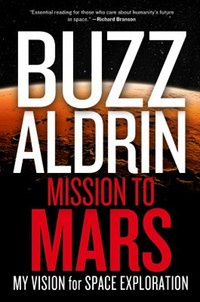Review: Mission to Marsby Jeff Foust
|
| “Public space travel by private citizens or nonprofessionals is critical as it makes space feel more familiar,” he writes. “That appreciation, I feel, can shed today’s elitist nature of going into space.” |
It’s that Aldrin—the spaceflight expert and advocate—that authors Mission to Mars with the assistance of veteran space jouralist Leonard David. The title of the book is a bit misleading: one might think that he is advocating an all-out push to Mars, with no intermediate stops, as other space advocates, like Robert Zubrin, have called for. While Aldrin calls for an “American-led, permanent human presence on Mars by 2035,” he sees achieving that goal through a stepping-stone process of missions that build up experience and capabilities, what he calls the Unified Space Vision.
Much of the book traces Aldrin’s vision of sending humans to Mars. He sees great promise for commercial spaceflight sending space tourists (or, as he calls then, “global space explorers”) on suborbital and orbital flights, lowering the cost of space access but also fostering greater public support for spaceflight. “Public space travel by private citizens or nonprofessionals is critical as it makes space feel more familiar,” he writes. “That appreciation, I feel, can shed today’s elitist nature of going into space.”
For the Moon, Aldrin is concerned about the development of a new race to return humans there, and says a better approach is to develop an international consortium, modeled after the original Intelsat a half-century ago, to develop a lunar outpost and other infrastructure to support scientific studies and commercial development there. He also endorses human missions to near Earth asteroids and comets and, later, to the moons of Mars, both to build up experience for those eventual human Martian landings as well as in their own right.
Although the book is focused primarily on the technical issues of sending humans to Mars, Aldrin does offer some personal reflections. The first chapter of his book interleaves his own story of becoming an astronaut and going to the Moon with his desire to restart a new era of space exploration. In the chapter about the Moon, he recalls his Apollo 11 experience, and addresses a sore point for some: that most of the pictures from that historic moonwalk feature Aldrin, not Armstrong. “I’m not trying to ease out of any public relations perspective, but we were never briefed on how important the PR pictures would be,” he explains. And he offers this as well: “Once I set foot on the moon, I checked my balance and peed in my space suit’s urine collector.” Okay, then.
| Aldrin argues that the next US President—elected in 2016—should make a “bold statement” on the 50th anniversary of Apollo 11 in July 2019 by setting of a goal of “commencing American permanence on the planet Mars” within 20 years. |
For those who have been paying attention to Aldrin’s comments at various space conferences and other events, there’s little new here technically in Mission to Mars. The Unified Space Vision concept, for example, is something Aldrin has been promoting for several years; the Mars “cycler” spacecraft concept, featuring spacecraft in orbits that swing them by Earth and Mars on a regular basis, is much older.
The emphasis of the book is very much on the “how” of space exploration, with chapters often profiling a grab bag of different technologies or mission concepts. There is far less in the book, though, on “why” humans should go to Mars, beyond a desire to maintain US leadership in space. The book makes little mention of the costs of these mission concepts as well, a key criterion in an era of constrained budgets.
In the book, Aldrin argues that the next US President—elected in 2016—should make a “bold statement” on the 50th anniversary of Apollo 11 in July 2019 by setting of a goal of “commencing American permanence on the planet Mars” within 20 years. (How he and others will convince that future president to endorse that goal is not discussed, although in a speech earlier this month at the Humans to Mars Summit in Washington, he said that if that president declined to make that goal, “it would be a wonderful opportunity for that person trying to unseat the incumbent by saying, ‘I’m going to make that commitment early in my term.’”) That unaddressed challenge may be far more difficult that any technical obstacle towards achieving the goal of Mission to Mars, and it’s not something even Aldrin’s celebrity can easily overcome.
